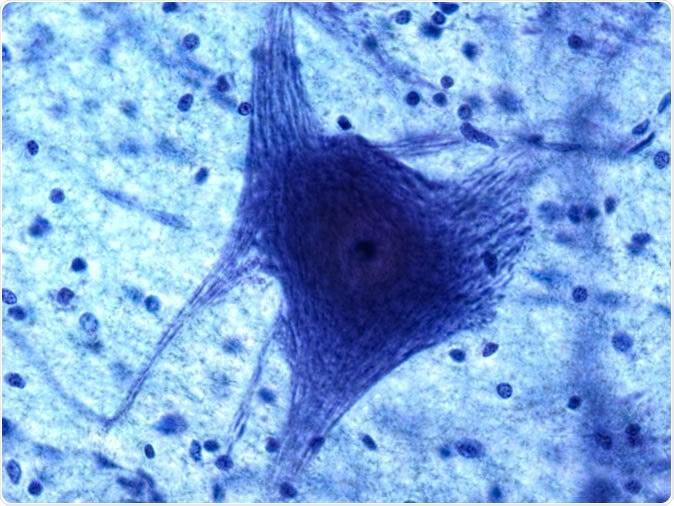A new study has shown that glial cells of the gut (part of the enteric nervous system) when exposed to secretions from colon cancer cells are convert into tumours themselves. These altered glial cells then convert into promoters of tumours said the study researchers.
This study reveals the importance of the enteric or gut glial cells in development of tumours and also lays the foundation of new treatment targets for colon cancer. The study appeared in the latest issue of the journal EBioMedicine. The study is titled, “Tumor cells hijack enteric glia to activate colon cancer stem cells and stimulate tumorigenesis.”

Neuron and glia at 60x. Image Credit: Christopher Meade / Shutterstock
The French researchers in collaboration with those from North Carolina State University, explained that the gut contains a wide network of nervous system called the enteric nervous system. This a local nervous system that contains enteric glial cells (EGCs) which regulate several intestinal functions including movement of the gut or peristalsis that plays an important role in digestion. This system is integral to the functions of the intestinal lining and epithelial layer of the intestine. In case of a cancer growing with the intestine the tumour itself creates a microenvironment within the gut. This environment comprises of neurons, enteric glial cells, immune cells, signally molecules and capillary blood vessels. The researchers have known from previous evidence that there is an intense interaction between each of the components of this microenvironment.
The team explains that the colon cancer stem cells are the main initiators of the colon cancer tumours. These CSCs are also responsible for relapse of the tumours. They wrote that these cells are “constantly exposed to regulatory cues emanating from neighboring cells present in the tumour microenvironment.” They planned to study the effect of enteric glial cells on tumour initiation by the CSCs.
Laurianne Van Landeghem, assistant professor of neurogastroenterology at NC State, one of the authors of the study said, “Only a fraction of cancer cells - known as colon cancer stem cells, or CSCs - is thought to be able to create tumours. CSCs are constantly exposed to regulatory cues in the form of molecules secreted by neighbouring cells in the tumour microenvironment.” She added, “EGCs are an important part of the tumour microenvironment, but no one had studied whether these cells affect the CSCs' ability to create new tumours.”
The team included Ph.D. student Simon Valès from the University of Nantes, France. They looked at the tumours of the colon among American as well as French patients. Van Landeghem said, “We isolated CSCs from the tumours and grew them in presence or absence of glial cells to see if the EGCs' secretions affected tumour initiation and growth.” They noted that when the colon cancer stem cells were exposed to the enteric glial cells which had not earlier encountered the cancer cells (grown alone), there was no significant growth of the tumour. In their next experiment the team grew the enteric glial cells in a medium where they had earlier grown tumour cells. These secretions were then brought into contact with colon cancer stem cells. Now the cancers or tumours were found to grow more quickly and were bigger than before say the researchers.
The team wrote about their study saying, “results show that EGCs, once activated by the tumor, acquire a pro-tumorigenic phenotype and stimulate CSC-driven tumorigenesis via a PGE2/EP4/EGFR-dependent pathway.” They added, “. Specifically, we show that tumor epithelial cell-derived IL-1 activates enteric glial cells to produce and release increased quantities of PGE2 leading to increased cancer stem cell tumour-initiating capabilities and tumour growth.”
According to Van Landeghem, “In the tumour microenvironment, the cancer cells secrete a molecule known as IL-1, which, if taken up by nearby EGCs, can change them. Those changed glia in turn secrete a molecule known as PGE2, which stimulates the CSCs and causes tumour initiation and faster tumour growth. Both of these molecules are well described, but we didn't know they were involved in the communication between the tumor and glial cells until now.” She explained the phenomenon saying, “The tumour is essentially remodelling the nearby glia with the aim of making itself thrive.” She said, “We have identified the molecules responsible for this remodeling and EGCs' pro-tumor initiation impact. Hopefully this work can lead to better understanding of the role EGCs play in colon cancer and perhaps help us identify new targets for cancer therapies.”
Speaking on the implications this study may have on future drug research, the team wrote, “enteric glial cells are active players of colon carcinogenesis and indicates that a better understanding of the molecular pathways involved in the bi-directional crosstalk between enteric glial cells and colon cancer (stem) cells may lead to the identification of new therapeutic targets for anti-cancer therapies.”
This study was funded by the French National Cancer Institute, La Ligue contre le Cancer, the 'Région des Pays de la Loire', and the UNC Lineberger Comprehensive Cancer Care Center.
Journal reference:
Tumor cells hijack enteric glia to activate colon cancer stem cells and stimulate tumorigenesis Valès, Simon et al. EBioMedicine, https://www.ebiomedicine.com/article/S2352-3964(19)30652-8/fulltext